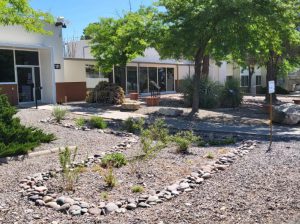 Pollinators play a crucial role in both human agriculture and ecosystems by supporting thousands of plant species and crops which feed humans and livestock. Unfortunately, habitat loss, disease, and pesticides contribute to the decline in pollinator biodiversity worldwide, which has led to a substantial reduction in native bee species, impacts to honeybees, and the decline of the iconic Monarch Butterfly. In their efforts to integrate sustainable design, several NASA centers have implemented measures promoting preservation of pollinator habitats though gardens, meadows, and other initiatives.
Pollinators play a crucial role in both human agriculture and ecosystems by supporting thousands of plant species and crops which feed humans and livestock. Unfortunately, habitat loss, disease, and pesticides contribute to the decline in pollinator biodiversity worldwide, which has led to a substantial reduction in native bee species, impacts to honeybees, and the decline of the iconic Monarch Butterfly. In their efforts to integrate sustainable design, several NASA centers have implemented measures promoting preservation of pollinator habitats though gardens, meadows, and other initiatives.
In addition to a registered Monarch Waystation, Langley Research Center (LaRC) is home to beehive colonies following two rescue missions on center. The first occurred in April of 2023, when a swarm of honeybees was discovered under a picnic table near the cafeteria. To relocate this colony, the center enlisted the help of LaRC personnel Dr. Jeremy Pinier, a member of the Colonial Beekeepers Association, along with his 6-year-old daughter Olivia, his apprentice beekeeper. The bees were relocated to a habitat near the community garden, which hosts 16 year-round and 24 seasonal plots rented by active members of the LaRC Garden Club. The second hive was relocated in April 2024 from a service vehicle’s truck bed. The bees are flourishing and have earned the nickname “The Artemis Colony,” coined by Dr. Pinier. Center personnel have enjoyed the colony’s honey and remain committed to nurturing its bee population and preserving the garden for the future.






